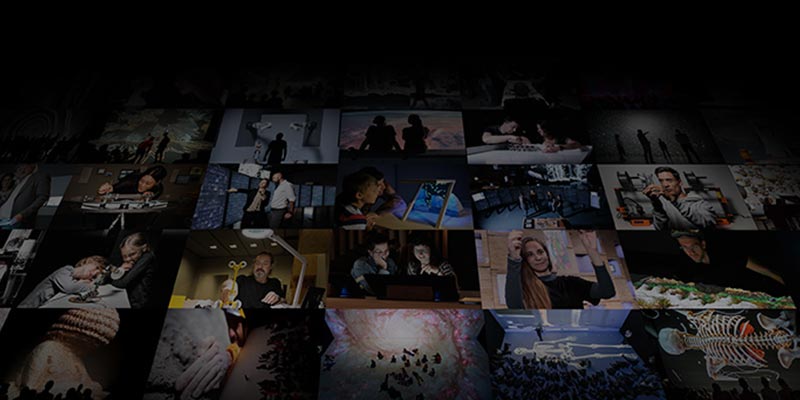Following last year’s brilliant 40-year festival, which brought more artists, exhibitors and international experts to Linz than ever before, this year Ars Electronica is going on a journey, or rather the festival itself is becoming a journey – a journey through “Kepler’s Gardens”, which are not just located in Linz at the JKU Campus but also 120 other locations worldwide.
This time with Home Delivery’s Inside Festival programme we travel to South America and explore locations in Chile.
The Ars Electronica Garden Cape Horn Island is hosting Achæoscillator_Towards Incorporeal Forms of Sensing, Listening and Gaze, an ongoing research and AR/VR immersive installation that uses the natural energies and drastic conditions of the southernmost island on Earth to build a virtualized representation of the end/start of the Americas. A virtual hub to travel, as a one-person experience, to the remote island of Cape Horn, 55°57’49.6”S 67°13’09.9”W, where extreme weather conditions offer inestimable and uncontrollable evidence of Gaia’s power. Terra Ignota Research Group focuses on these inputs to create site-specific monumental installations which visitors to the festival will experience through virtual reality. The purpose of this research is to trace the presence and significance of acoustic phenomena in relation to the myths and beliefs of indigenous populations present in Tierra del Fuego, the interethnic traces are bio-cultural routes to the past, especially as pertains to the ancestors of the Yagán, the Kawesqar and the Selk’nam in the Almirantazgo Sound area. Attention is also brought to how the Antarctic, Scotia and South America continental plates collide there.
A Fungus Garden of Ars Electronica Garden Santiago de Chile is a digital exhibition which invites you to know more about the importance of fungi and their marginality, being often associated with death. Through a multimedia online experience around the fungi kingdom, A Fungus Garden approaches human decay as a symbol of mystery and beauty, noticing the invisible webs in which we are embedded. The semantic universe of the word garden is often related to a designed outdoor space, either for leisure or the cultivation of edible plants. In the same idealized imagery, the fungi kingdom is represented through bright and colorful mushrooms, like the famous Amanita muscaria. But what is the role of fungi in a garden? How would a fungus-only garden look like? There are some known fungus gardens made by termites and ants. These insects cultivate fungal mycelium inside their underground galleries in order to feed from it. Both organisms, insect and fungus, create a symbiosis that maintains the balance.
The Valparaíso Brushwood Garden, also located in Chile, is an open task to envision a space in which creativity overcomes adversity and precariousness. Growing as brushwood in the wildlands, creativity always finds new materials to work with, new ways to survive, new forms to communicate ideas and create relationships, beyond economic approaches. This is an exercise to conceive an architectural common space for many artworks that symbolize several creative forms of life. Words, images, sounds, letters, gestures… all different sprouts that coexist and share a common place, unknown to the official cartographies. Spaces, Ecologies, Memories and Resistances are the main concepts in which this virtual space has been conceived and built. Against precarization or any monolithic idea of experience, Brushwood Garden seeks alternatives to imposed mapping forms or ways of inhabiting, always forcibly separated or stacked, many of them considered truly brushwoods. This sprouted garden is conceived as a communication spot between all artworks, a place that allows them to live in dignity, opening a possible future for arts and better ways of inhabiting. In this sense, virtual space is an experimental material to conceive new territories.
The final garden in Santiago de Chile, Prisma Garden, presents the SPACE / EARTH / WATER TRIAD. The three conceptual axes embody the main components of Chilean geography and the wide diversity of its natural terrain from north to south. They comprise projects developed by artists together with scientists, live-streamed performances, excursions, videos, and virtual environments at the crossroads of arts, science and technology. With the aim of exploring creative imaginaries that challenge traditional boundaries among these fields of knowledge, all of them outline alternative ways of living, thinking and feeling within our ever-changing environment. These axes will be exhibited and interconnected in an online platform called Xirius, where they will become nodes in an open network especially designed to share data, experiences, and other forms of conversation between artists, scientists, and institutions.
Finally, Ars Electronica Garden Austral is located in an incomparable natural and cultural ecosystem in the city of Valdivia. Everyone agrees that there will be a different world after the current global health emergency. But before we get to that after, we still have to get there. We are in the in-between. The uncertainty of the in-between is the moment of mutation. In the Chilean case, this experience overlaps with unprecedented social and political unrest: the mutation of the constitutional regime that has sustained the country since the 1973 coup d’état. This uncertain in-between where local political transformation overlaps with global instability, is the core of the Mutations, a proposal developed at Austral University of Chile. The program includes four activities that will present the city’s ecosystem and the southern macro-zone of Chile, in relation to historical, cultural, ecological and visual mutations. This artistic proposal includes eight works which address mutation as an internal condition of art: the place of theater in a world that is crumbling, landscapes of inorganic objects, mutations of domestic space in confinement, the boundary between nature and economy, the oral memory of women in confinement, the urban landscape and urban bodies crushed by the violence of the political revolt, the spectral sound of social claims in relation to their suspension due to the pandemic, and the archeology of the technological *mutation* in Chile. Seismographs of the in-between, these works are unfinished processes determined by the mutation.
This project is a cooperation between the Ministerio de las Culturas, las Artes y el Patrimonio, the Ministerio de Relaciones Exteriores | Gobierno de Chile and Ars Electronica.
Credit: Marcelo Raffo




